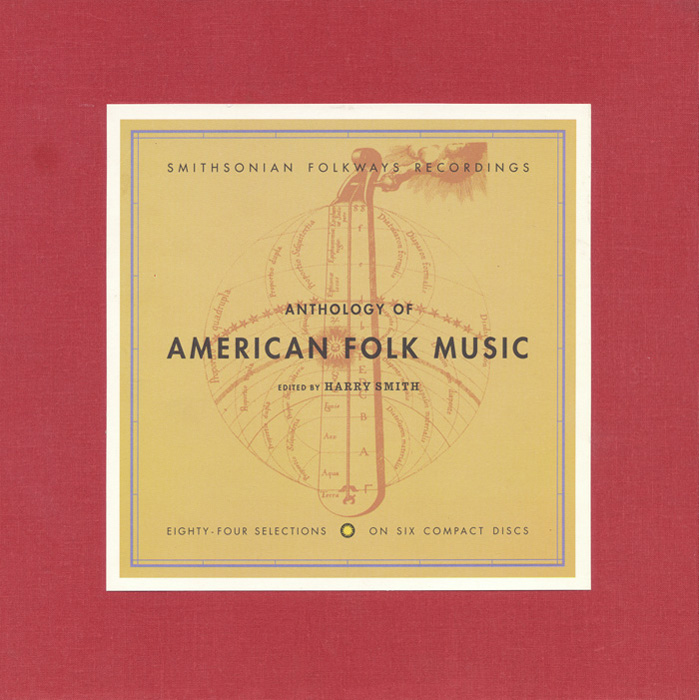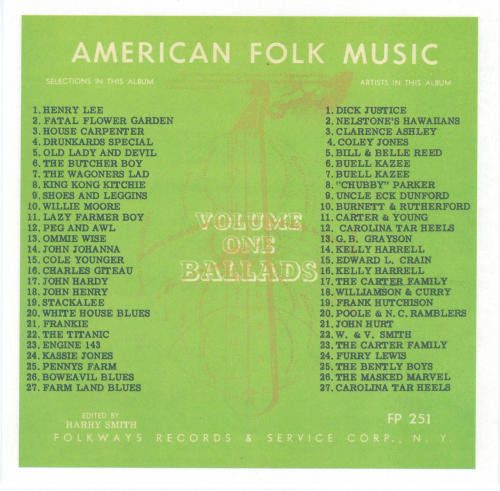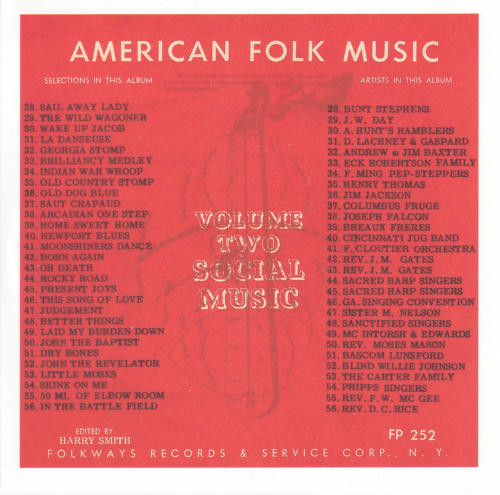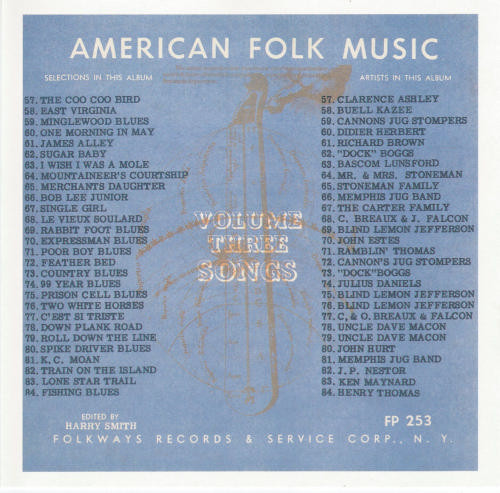I wandered into a strange fixation on pre-1950s music while sample some 78rpm records that were discovered from an in-law’s grandmother. At first listen, they might seem at times even a bit goofy to a modern listener but the rawness and ‘maturity’ of some of the songs surprised me. This brush against an era of music largely unknown to me led to discovering Harry Smith’s collection from the 1950s entitled “Anthology of American Folk Music.” Smith’s collection focused on a sliver of time from 1927 until 1932 and it was organized by broad genre across six vinyl LP records. It was re-released on CD in a nice box set.

I’ve seen some modern reviews complain about the sound quality of the songs in the collection and it is true that many sound quite imperfect, having been seemingly taken from sources that were surely not recorded or duplicated under optimal conditions. That said, such complaints miss the point.
The collection includes the following songs – I’ve added some comments where I found songs to be of interest. Note that my sharpest concentration was in the ballads since they often had the most historical ‘meat’ to them; your mileage may vary regarding which songs appeal to you.
Volume One: Ballads (Green Singing)
This volume contained the following songs:
1 ~ “Henry Lee” (1932) ~ Dick Justice ~ 3:26
The protagonist in this song revealed his interest in another woman to the possible-mother-of-his child. No surprise, the jealous girlfriend killed him. This was quite a note to start on and, while it is hard to fault the woman’s anger, she was later given the death penalty for the killing.
2 ~ “Fatal Flower Garden” (1930) ~ Nelstone’s Hawaiians ~ 2:55
The song lulled the listener into comfort by having an upbeat tone as it focused on a boy playing with a ball. When he ball landed in the yard of a supernatural-hinted ‘gypsy lady’ the story turned dark as it is strongly implied that the woman lured the boy into her house and killed him. The song was rooted in variations of a story going back centuries.
3 ~ “The House Carpenter” (1930) ~ Clarence Ashley ~ 3:14
A woman was lured away from her family, perhaps by the Devil (at least more explicitly so in other versions of this song) and met her demise while on a ship at sea. Again, dark and supernatural. Singer Clarence Ashley had a late career resurgence in the 1950s to 1960s after having been forced into manual labor in the 1940s.
4 ~ “Drunkard’s Special” (1929) ~ Coley Jones ~ 3:16
A drunken man faced mounting evidence that his wife was cheating on him. Keeping with the theme of seeming like a parody, this song also had a tone of darkness underneath it in the particulars of the scenario.
5 ~ “Old Lady and the Devil” (1928) ~ Bill & Belle Reed ~ 3:02
A farmer’s wife died and was taken to hell, but she was so tiresome that the Devil sent her back to her husband. Again, dark but also very tongue-in-cheek.
6 ~ “The Butcher’s Boy” (1928) ~ Buell Kazee ~ 3:02
The son of a butcher broke the heart of his girlfriend, leading her to commit suicide while leaving instructions that it be made clear that she died for love. Versions of this song have been covered into the modern day, with it being quite famous for its forsaken love theme.
7 ~ “The Waggoner’s Lad” (1928) ~ Buell Kazee ~ 3:02
8 ~ “King Kong Kitchie Kitchie Ki-Me-O” (1928) ~ Chubby Parker ~ 3:08
A frog was interested in marrying a mouse, but it has to defeat her other suitors. The dating of this song’s origin puts it back into the late 1500s England.
9 ~ “Old Shoes and Leggins” (1929) ~ Uncle Eck Dunford ~ 2:59
10 ~ “Willie Moore” (1927) ~ Dick Burnett and Leonard Rutherford ~ 3:13
11 ~ “A Lazy Farmer Boy” (1930) ~ Buster Carter and Preston Young ~ 2:57
12 ~ “Peg and Awl” (1929) ~ The Carolina Tar Heels ~ 2:57
13 ~ “Ommie Wise” (1929) ~ G. B. Grayson ~ 3:09
The 1808 murder of Naomi Wise was the backdrop of this song. Wise had been adopted into a family, eventually having an affair with the son of another family, Jonathan Lewis. Lewis was intending to marry a different woman though and, amid that complication, Naomi was found dead. She was pregnant and had been battered to death, with Lewis suspected of the crime.
14 ~ “My Name Is John Johanna” (1927) ~ Kelly Harrell ~ 3:12
15 ~ “Bandit Cole Younger” (1930) ~ Edward L. Crain ~ 2:54
Cole Younger was a leader of the James–Younger Gang, which unraveled during a bank robbery gone bad in Northfield, Minnesota. Younger would later be apprehended and die in prison.
16 ~ “Charles Guiteau” (1927) ~ Kelly Harrell ~ 3:03
Charles Guiteau was responsible for the assassination of President James Garfield in 1882, claiming that he was operating under divine instruction. Although Guiteau shot Garfield, it was the poor medical hygiene of the time that did in the president, leading to multiple infections. Guiteau was sometimes mistakenly attributed as the writer of this song, due to confusion with his having written an unrelated poem on the day of his execution.
17 ~ “John Hardy Was a Desperate Little Man” (1930) ~ The Carter Family ~ 2:55
John Hardy was a railroad worker living in West Virginia who killed a man named Thomas Drews during a drunken craps game in 1893. Hardy was later hung, but his story in this song gained significant coverage by folk artists in later years, with a hook of sorts involving Hardy having allegedly been baptized on the morning of his hanging.
18 ~ “Gonna Die with My Hammer in My Hand” (1927) ~ Wiliamson Brothers and Curry ~ 3:24
19 ~ “Stackalee” (1927) ~ Frank Hutchison ~ 2:58
A St. Louis pimp named ‘Stag’ Lee Shelton got into a dispute with a rival named Billy Lyons over Shelton’s Stetson hat. Despite Lyons dying from his injuries, Shelton managed to only serve around a decade in prison for the murder. Of course, he died while back in prison a few years later for an unrelated robbery.
20 ~ “White House Blues” (1926) ~ Charlie Poole w/ North Carolina Ramblers ~ 3:31
The presidential assassination theme continued with this song about the death of President William McKinley in 1901. McKinley was killed by Leon Czolgosz via a pistol that had been concealed under a cloth rag. Like the case of Garfield, McKinley died in the aftermath of being shot from complications. Czolgosz was an anarchist who was executed seven weeks after the shooting.
21 ~ “Frankie” (1928) ~ Mississippi John Hurt ~ 3:25
A woman named Frankie caught her boyfriend cheating on her and killed the man. The song was likely based on aspects of the case of Frankie Baker, a 22 year old woman from St. Louis, Missouri, who managed to escape conviction for the killing of her 17 year old boyfriend.
22 ~ “When That Great Ship Went Down” (1927) ~ William and Versey Smith ~ 2:55
This was a version of a song about the 1912 sinking of the Titanic.
23 ~ “Engine 143” (1927) ~ The Carter Family ~ 3:16
The Chesapeake and Ohio Railway’s Fast Flying Virginian train wrecked in 1890 and that tragedy was the foundation for this song. The song built on the basic facts by adding hubris with the idea that the train engineer needed to make up time by speeding, a choice that would contribute to the accident. The engineer died in the wreck after staying aboard the train to slow it long enough to save as many passengers as possible.
24 ~ “Kassie Jones” (1928) ~ Furry Lewis ~ 6:13
This song was similar in nature to the prior one, this time focusing on the figure of Casey Jones, a train engineer who died in a train crash while trying to save his passengers. Jones built up notable hero status in the aftermath of the crash.
25 ~ “Down on Penny’s Farm” (1929) ~ The Bently Boys ~ 2:47
26 ~ “Mississippi Boweavil Blues” (1929) ~ Charlie Patton ~ 3:07
27 ~ “Got the Farm Land Blues” (1932) ~ The Carolina Tar Heels ~ 3:16
Volume Two: Social Music (Red Singing)
This volume contained the following songs:
1 ~ “Sail Away Lady” (1926) ~ Uncle Bunt Stephens ~ 2:56
2 ~ “The Wild Wagoner” (1928) ~ Jilson Setters ~ 3:14
3 ~ “Wake Up Jacob” (1929) ~ Prince Albert Hunt’s Texas Ramblers ~ 2:52
4 ~ “La Danseuse” (1929) ~ Delma Lachney and Blind Uncle Gaspard ~ 2:54
5 ~ “Georgia Stomp” (1929) ~ Andrew & Jim Baxter ~ 2:44
6 ~ “Brilliancy Medley” (1930) ~ Eck Robertson and Family ~ 2:59
7 ~ “Indian War Whoop” (1928) ~ Floyd Ming and his Pep-Steppers ~ 3:10
8 ~ “Old Country Stomp” (1928) ~ Henry Thomas ~ 2:52
9 ~ “Old Dog Blue” (1928) ~ Jim Jackson ~ 3:01
This was a very common ode to a man’s dog that has many recorded variants, having originated in the later 1800s.
10 ~ “Saut Crapaud” (1929) ~ Columbus Fruge ~ 2:47
11 ~ “Acadian One Step” (1929) ~ Joseph Falcon ~ 2:57
12 ~ “Home Sweet Home” (1933) ~ The Breaux Freres (Clifford Breaux, Ophy Breaux, Amedee Breaux) ~ 3:00
This song contained vivid talk of yearning for home. Apparently, the lyrics were considered so tempting that a version of the song was banned by the Union Army during the Civil War for fear that men might be inspired to desert.
13 ~ “Newport Blues” (1929) ~ Cincinnati Jug Band ~ 2:55
14 ~ “Moonshiner’s Dance Part One” (1927) ~ Frank Cloutier and the Victoria Cafe Orchestra ~ 2:39
15 ~ “Must Be Born Again” (1927) ~ Rev. J. M. Gates ~ 1:28
16 ~ “Oh Death Where Is Thy Sting” (1927) ~ Rev. J. M. Gates ~ 1:26
17 ~ “Rocky Road” (1928) ~ Alabama Sacred Harp Singers ~ 2:42
18 ~ “Present Joys” (1928) ~ Alabama Sacred Harp Singers ~ 2:50
19 ~ “This Song of Love” (1932) ~ Middle Georgia Singing Convention No. 1 ~ 2:56
20 ~ “Judgement” (1927) ~ Sister Mary Nelson ~ 2:23
21 ~ “He Got Better Things for You” (1929) ~ Memphis Sanctified Singers ~ 2:52
22 ~ “Since I Laid My Burden Down” (1929) ~ Elders McIntorsh and Edwards’ Sanctified Singers ~ 3:16
A simple verse was repeated in variation for sizeable effect with allusions to the Christian act of laying down one’s burdens.
23 ~ “John the Baptist” (1928) ~ Moses Mason ~ 3:02
24 ~ “Dry Bones” (1929) ~ Bascom Lamar Lunsford ~ 2:58
This was a compilation of small pieces, focusing on no less than five different Bible stories. It began with the story of Enoch from Genesis 5:21-24, then continued on to Acts 16:25-26. The story of Moses and the burning bush from Exodus 3:2 was next, then the story from Ezekiel 37:1-10. The final verse seemed to touch on Genesis 3 with the story of Adam and Eve.
25 ~ “John the Revelator” (1930) ~ Blind Willie Johnson ~ 3:18
A call-and-response song about John, the writer of the Biblical book of Revelation.
26 ~ “Little Moses” (1932) ~ The Carter Family ~ 3:11
27 ~ “Shine on Me” (1930) ~ Ernest Phipps and His Holiness Singers ~ 3:01
28 ~ “Fifty Miles of Elbow Room” (1931) ~ Rev. F.W. McGee ~ 2:40
29 ~ “I’m in the Battle Field for My Lord” (1929) ~ Rev. D.C. Rice and His Sanctified Congregation ~ 3:19
Volume Three: Songs (Blue Singing)
This volume contained the following songs:
1 ~ “The Coo Coo Bird” (1929) ~ Clarence Ashley ~ 2:54
A singer’s internal monologue about his need to regain a lost lover and the risks that he’ll take to achieve that goal.
2 ~ “East Virginia” (1929) ~ Buell Kazee ~ 2:58
3 ~ “Minglewood Blues” (1928) ~ Cannon’s Jug Stompers ~ 3:05
This song was similar to the more-well-known “Rollin’ and Tumblin'” about a relationship gone bad and the misery around its failure.
4 ~ “I Woke Up One Morning in May” (1929) ~ Didier Hebert ~ 3:01
5 ~ “James Alley Blues” (1927) ~ Richard Rabbit Brown ~ 3:05
6 ~ “Sugar Baby” (1928) ~ Dock Boggs ~ 2:56
7 ~ “I Wish I Was a Mole in the Ground” (1928) ~ Bascom Lamar Lunsford ~ 3:19
There appeared to have been some disagreement on the intent of this song, but Harry Smith’s notes insisted that it was a sort of surrealist take on being a mole (and a lizard).
8 ~ “Mountaineer’s Courtship” (1926) ~ Ernest Stoneman and Hattie Stoneman ~ 2:42
9 ~ “The Spanish Merchant’s Daughter” (1930) ~ The Stoneman Family ~ 3:15
10 ~ “Bob Lee Junior Blues” (1927) ~ The Memphis Jug Band ~ 3:08
11 ~ “Single Girl, Married Girl” (1927) ~ The Carter Family ~ 2:44
12 ~ “Le vieux soûlard et sa femme” (1928) ~ Cleoma Breaux and Joseph Falcon ~ 3:08
13 ~ “Rabbit Foot Blues” (1927) ~ Blind Lemon Jefferson ~ 2:55
This song returned in a way to the supernatural bend present in some earlier songs by focusing on the notion of a rabbit’s foot, the popular good luck charm. The history of the rabbit’s foot was more occult than modern people might assume, with its superstitious nature and use as a proxy for bones.
14 ~ “Expressman Blues” (1930) ~ Sleepy John Estes and Yank Rachell ~ 3:01
15 ~ “Poor Boy Blues” (1929) ~ Ramblin’ Thomas ~ 2:22
16 ~ “Feather Bed” (1928) ~ Cannon’s Jug Stompers ~ 3:13
17 ~ “Country Blues” (1928) ~ Dock Boggs ~ 2:56
18 ~ “99 Year Blues” (1927) ~ Julius Daniels ~ 3:04
19 ~ “Prison Cell Blues” (1928) ~ Blind Lemon Jefferson ~ 2:44
20 ~ “See That My Grave Is Kept Clean” (1928) ~ Blind Lemon Jefferson ~ 2:52
21 ~ “C’est si triste sans lui” (1929) ~ Cleoma Breaux and Ophy Breaux w/ Joseph Falcon ~ 2:59
22 ~ “Way Down the Old Plank Road” (1926) ~ Uncle Dave Macon ~ 2:58
23 ~ “Buddy Won’t You Roll Down the Line” (1930) ~ Uncle Dave Macon ~ 3:15
24 ~ “Spike Driver Blues” (1928) ~ Mississippi John Hurt ~ 3:14
The legend of the famous railroad builder John Henry, who took on a mechanical rock drilling machine and died from heart failure after being victorious.
25 ~ “K.C. Moan” (1929) ~ The Memphis Jug Band ~ 2:31
26 ~ “Train on the Island” (1927) ~ J.P. Nestor ~ 2:57
27 ~ “The Lone Star Trail” (1930) ~ Ken Maynard ~ 3:12
28 ~ “Fishing Blues” (1928) ~ Henry Thomas ~ 2:44
This concluding song of the collection seemed appropriate if only because there was more depth to it than appeared at first glance. One might assume it to be a song about the pleasures of fishing in a literal sense but there was also a blues undercurrent of sexuality with fishing meaning more than one might assume.
- Over-sized KO Transformers Reviewed - March 29, 2025
- Recapping Criterion’s Lone Wolf & Cub Films - December 29, 2024
- Moonlighting (1985) – A Series Review - September 12, 2024



